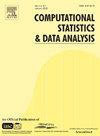简:只是另一个潜在空间网络聚类算法
IF 1.6
3区 数学
Q3 COMPUTER SCIENCE, INTERDISCIPLINARY APPLICATIONS
引用次数: 0
摘要
虽然潜在空间网络模型已经成为社区检测的流行方法超过15年,但主要的计算挑战仍然存在,限制了扩展到小型网络之外的能力。R统计软件包JANE引入了一种新的估计算法,该算法具有巨大的速度提升,其源自:(1)一种低维近似方法来调整程度异质性参数;(2)难以处理的似然项的近似;(3)快速初始化算法;(4)基于聚类性能的一套新的收敛准则。此外,所提出的方法解决了当前实现的局限性,即依赖于潜在位置先验分布的限制性球形假设;放宽这个限制可以在不同的网络结构中获得更大的灵活性。一项模拟研究评估了所提出的方法与最先进的方法的聚类性能,结果表明,在大多数情况下,该方法的聚类性能都得到了显著提高,计算时间也显著减少——与现有方法相比,速度提高了45倍。本文章由计算机程序翻译,如有差异,请以英文原文为准。
JANE: Just Another latent space NEtwork clustering algorithm
While latent space network models have been a popular approach for community detection for over 15 years, major computational challenges remain, limiting the ability to scale beyond small networks. The R statistical software package, JANE, introduces a new estimation algorithm with massive speedups derived from: (1) a low dimensional approximation approach to adjust for degree heterogeneity parameters; (2) an approximation of intractable likelihood terms; (3) a fast initialization algorithm; and (4) a novel set of convergence criteria focused on clustering performance. Additionally, the proposed method addresses limitations of current implementations, which rely on a restrictive spherical-shape assumption for the prior distribution on the latent positions; relaxing this constraint allows for greater flexibility across diverse network structures. A simulation study evaluating clustering performance of the proposed approach against state-of-the-art methods shows dramatically improved clustering performance in most scenarios and significant reductions in computational time — up to 45 times faster compared to existing approaches.
求助全文
通过发布文献求助,成功后即可免费获取论文全文。
去求助
来源期刊

Computational Statistics & Data Analysis
数学-计算机:跨学科应用
CiteScore
3.70
自引率
5.60%
发文量
167
审稿时长
60 days
期刊介绍:
Computational Statistics and Data Analysis (CSDA), an Official Publication of the network Computational and Methodological Statistics (CMStatistics) and of the International Association for Statistical Computing (IASC), is an international journal dedicated to the dissemination of methodological research and applications in the areas of computational statistics and data analysis. The journal consists of four refereed sections which are divided into the following subject areas:
I) Computational Statistics - Manuscripts dealing with: 1) the explicit impact of computers on statistical methodology (e.g., Bayesian computing, bioinformatics,computer graphics, computer intensive inferential methods, data exploration, data mining, expert systems, heuristics, knowledge based systems, machine learning, neural networks, numerical and optimization methods, parallel computing, statistical databases, statistical systems), and 2) the development, evaluation and validation of statistical software and algorithms. Software and algorithms can be submitted with manuscripts and will be stored together with the online article.
II) Statistical Methodology for Data Analysis - Manuscripts dealing with novel and original data analytical strategies and methodologies applied in biostatistics (design and analytic methods for clinical trials, epidemiological studies, statistical genetics, or genetic/environmental interactions), chemometrics, classification, data exploration, density estimation, design of experiments, environmetrics, education, image analysis, marketing, model free data exploration, pattern recognition, psychometrics, statistical physics, image processing, robust procedures.
[...]
III) Special Applications - [...]
IV) Annals of Statistical Data Science [...]
 求助内容:
求助内容: 应助结果提醒方式:
应助结果提醒方式:


